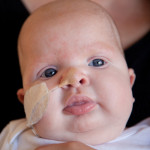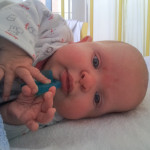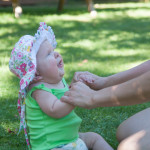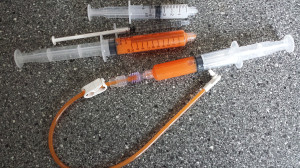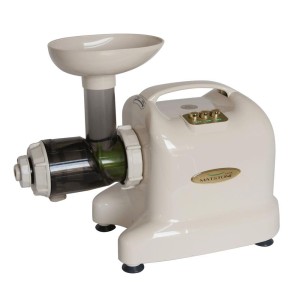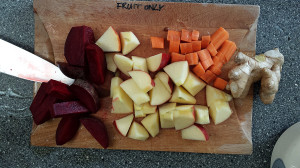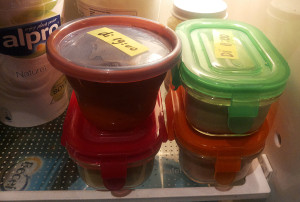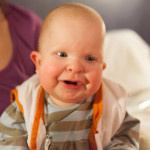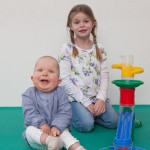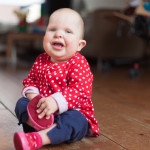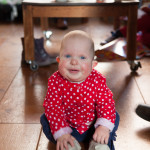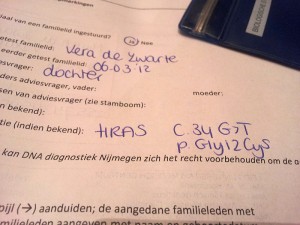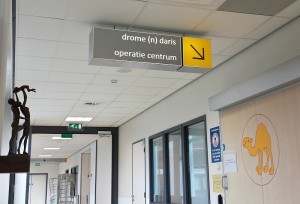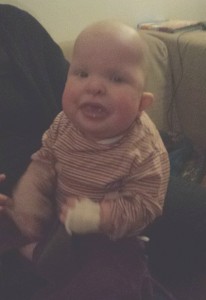“Have some leniency with her”, Vera’s eye doctor said at the beginning of her life. What he meant is that we needed to be patient. That she really would develop, but that it would take time. More time than with a typical developing child. And he is right, slowly but surely we can see an upward trend with Vera.
One of the main characteristics of Costello syndrome is developmental delay. Everything is very slow (or in some cases doesn’t develop at all) and we see this in Vera also. But if we look at all the facts, we can see several jumps in her development.
The first jump was early in her life, it was the moment she was no longer in intensive care and came home with us for a couple of weeks. During those weeks we saw progress, until another hospital stay followed and things halted again.
A real jump came the moment the feeding tube came out of her nose because she received a PEG (feeding tube in her stomach). The negative sensations in her nose and throat were gone. This really benefitted her, in particular in making sounds for instance.
On vacation in the summer of 2013 we noticed she was feeling well and that her development continued. Being outside often with nice weather and always having people (without white coats) around to smile at were exactly what she needed and are things that she enjoys.
There have not been any more hospitalizations since October 2013 and a new development in play and discovering the world is taking place.
And then the biggest step to date; this February we made a change in her food. With tremendously positive effects. In the past there were problems with her bowels, she had cramps and ongoing diarrhea. A real solution had not been found. She would often spit up food and mucus several times a day; for sure in the mornings, but also often in the middle of the night so that we had to change all her bedding.
From our closed Facebook-group for parents with a child with Costello syndrome we got the tip that the special tube formula for children who are lactose intolerant caused problems in some children when used for a prolonged period of time. It is unclear why. After all, it is the most allergy free food in liquid form that contains all necessary nutrients. In consultation with our main pediatrician we stopped the special formula for a couple of days as a test and substituted with pure soy milk as her main source of nutrition.
The effect was that within a couple of days she stopped spitting up her food, produced less mucus and for the first time of her life had a solid stool. Her skin calmed down, was less splotchy and even somewhat softer.
A week after, she even slept through the night for the first time in her life. Unfortunately, the latter was just the one time.
It made such a big difference that we have switched to our own food. In the USA a so called ‘blended diet’ is used: you puree your own food in the blender so it can be administered through a feeding tube.
And so now we are in the kitchen for an hour every day weighing grams, calculating the calories, taking notes in a food diary and pureeing with the blender or the slow juicer (thanks to donations!). Grinding up sunflower seeds, mashing avocados, pureeing cooked rice, juicing vegetables: it all turns into beautiful porridge.
Instead of using the food pump with a very slow drip of two hours so she wouldn’t spit up, feeding her now only takes 20 minutes per feed.
Only the first and the last feeding of the day are still by food pump (soy milk with baby cereal), but we no longer have to get up out of bed in the middle of the night to turn the pump off and rinse all the equipment out…
It seems like making your own food would take more time, but not having to change her bedding and not having to change her clothes at least twice a day due to her spitting up actually saves us time. And above all: it gives Vera so much more quality of life that we gladly do this for her.
And because she no longer has diarrhea and is no longer spitting up, she is even more cheerful and likes to explore more. She is even more interested in solid food. So with every meal, she joins in and tastes, sometimes she chews a little and sometimes she even swallows a little. And, at two years of age, this is a very good development for someone with Costello syndrome.
Video food therapy:

